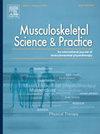Muscle strength is a key predictor of physical function in advanced knee osteoarthritis
IF 2.2
3区 医学
Q1 REHABILITATION
引用次数: 0
Abstract
Skeletal muscle strength of the lower limbs is negatively impacted in advanced knee osteoarthritis. However, its role in predicting physical function of these patients remains unclear. Therefore, we aimed to evaluate hierarchical linear regression associations between lower limbs' maximal muscle strength, rate of force development and physical function in 50 patients (age: 65 ± 8 years; 22 males and 28 females; and BMI: 31 ± 5 kg/m2) with advanced knee osteoarthritis. Results revealed that leg press maximal strength and leg extension maximum voluntary contraction were associated with sit-to-stand and stair climbing performance (all p < 0.001) and accounted for variances of 29 % and 38 % in 30-s sit-to-stand and 37 % and 24 % in stair climbing performance, respectively. Leg press maximal strength and leg extension maximum voluntary contraction were also associated with Knee Injury and Osteoarthritis Outcome Score - Physical Function Short Form (KOOS-PS) (both p = 0.041), each accounting for 7 % of the variance. Similarly, rate of force development was associated with 30-s sit-to-stand (p < 0.001) and stair climbing performance (p = 0.05), explaining 22 % and 6 % of additional variances, respectively. No association was observed between measures of muscle strength and 40 m fast-paced walking. The present study highlights maximal muscle strength, and in part rate of force development, as powerful predictors of physical function in patients with advanced knee osteoarthritis and may be used as simple, valuable measures when evaluating patients’ physical function.
肌肉力量是晚期膝关节骨关节炎患者身体功能的关键预测指标
下肢骨骼肌力量在晚期膝关节骨关节炎中受到负面影响。然而,其在预测这些患者身体功能方面的作用尚不清楚。因此,我们旨在评估50例患者(年龄:65±8岁;男性22人,女性28人;BMI: 31±5 kg/m2),膝关节骨性关节炎晚期。结果显示,腿压最大力量和腿伸展最大自主收缩与坐立和爬楼梯的表现有关(p <;0.001),在30秒的坐姿站立和爬楼梯表现中分别占29%和38%和37%和24%的差异。腿部按压最大力量和腿部伸展最大自主收缩也与膝关节损伤和骨关节炎结局评分-身体功能简表(KOOS-PS)相关(均p = 0.041),各占方差的7%。同样,力的发展速度与30秒的坐姿-站立(p <;0.001)和爬楼梯表现(p = 0.05),分别解释了22%和6%的额外方差。肌肉力量测量与40米快节奏步行之间没有关联。本研究强调最大肌力和部分力量发展速度是晚期膝关节骨关节炎患者身体功能的有力预测指标,可作为评估患者身体功能的简单而有价值的措施。
本文章由计算机程序翻译,如有差异,请以英文原文为准。
求助全文
约1分钟内获得全文
求助全文
来源期刊

Musculoskeletal Science and Practice
Health Professions-Physical Therapy, Sports Therapy and Rehabilitation
CiteScore
4.10
自引率
8.70%
发文量
152
审稿时长
48 days
期刊介绍:
Musculoskeletal Science & Practice, international journal of musculoskeletal physiotherapy, is a peer-reviewed international journal (previously Manual Therapy), publishing high quality original research, review and Masterclass articles that contribute to improving the clinical understanding of appropriate care processes for musculoskeletal disorders. The journal publishes articles that influence or add to the body of evidence on diagnostic and therapeutic processes, patient centered care, guidelines for musculoskeletal therapeutics and theoretical models that support developments in assessment, diagnosis, clinical reasoning and interventions.
 求助内容:
求助内容: 应助结果提醒方式:
应助结果提醒方式:


